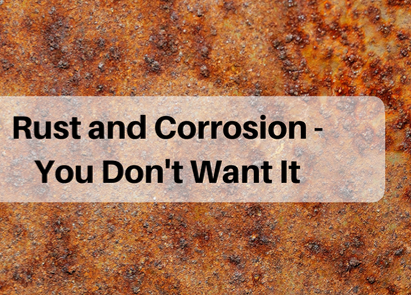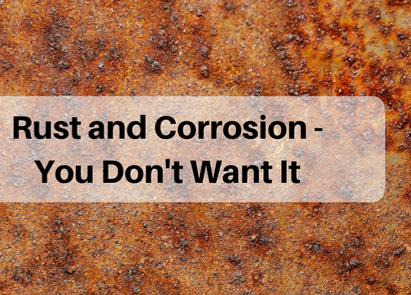Understanding Corrosion and How to Protect Against It

- Direct loss or damage of metal structures due to corrosion. An example is a hot water tank that has corroded and must be scrapped.
- Maintenance costs attributed to corrosion. Any metal surface that must be painted every few years to control corrosion falls into this area.
- Indirect losses resulting from corrosion. These losses may result from leakage and fires. Explosions attributed to leakage, power failures, facility shutdown and labor losses are also indirectly the result of corrosion.
What is rust?
When iron or steel corrodes, the result is iron oxide, or what we call rust. Steel is mostly composed of iron ore. In its natural state, iron ore looks much like rust: dark red and finely grained, with a tendency to hold moisture. Iron ore is a stable substance until it is converted into iron or steel, naturally weaker elements. When steel is exposed to moisture and oxygen, it immediately starts regressing to its natural state. Although protective measures have been taken, a large part of the steel made in this century has already rust back to an oxide, its natural state. Three elements are required for corrosion to exist: a protected metal, a corroded metal, and a current-conducting medium between the two. When two dissimilar metals are brought into contact, one will become the protected metal, and the other will become the corroded metal. Plant operators may recognize environmental situations that are conducive to corrosion.For example:
- If galvanized fittings are used on steel pipe, the galvanized (zinc) fitting will become corroded, while the steel remains protected.
- Steel or other metals under stress will become corroded, while the unstressed steel is protected from corrosion. This is the reason you see rust pitting on steel.
- Freshly cut steel will corrode more rapidly. Threads cut on pipe will always rust first.
- Adding salt to water greatly enhances its current-carrying ability. Thus, steel exposed to seawater or salt spray will corrode more rapidly than steel in fresh water. Atmospheric corrosion is greater in areas near the oceans, due to the effect of salt air. Concentrated brine solutions, such as those used in the food-processing industry, cause severe corrosion.
- Industrial smoke and fumes contain acids, alkalies and other chemicals, which serve as current conductors. Consequently, atmospheric corrosion in industrial areas is more severe than in rural areas.
- Soil, clay and earth materials are also good conductors of electricity. Pipelines and other steel buried in the ground will be prone to corrosion unless protected. Just as soil varies considerably in composition, it also varies in its electric conductivity: some soils cause more severe corrosion than others.
Corrosion control
To make the use of steel and other metals practical in construction and manufacturing, some corrosion-protection practices must be employed. Otherwise, the life of steel and other metals will be limited, reducing efficiency and escalating the cost of maintenance. There are several effective ways to stop corrosion:- Impressed current. By using suitable current-generating equipment and controls, it is possible to reproduce a current equal in strength to the corroding current, but flowing in the opposite direction. This type of protection is generally limited to pipelines, buried tanks, etc., and requires careful engineering and layout. Used improperly, an impressed current can promote corrosion.
- Sacrificial metals. Steel can be protected by adjacent placement to a dissimilar metal. For example, if zinc or magnesium is placed in direct contact with steel, it protects the steel from corrosion. Here, zinc and magnesium serve as sacrificial metals that not only protect the area of immediate contact, but also protect beyond the metal in each direction. Protection from rust by sacrificial metals is commonly used in several forms:
- Zinc or magnesium blocks are often used to protect ship hulls, water tank interiors and other submerged surfaces.
- Complete covering of the steel with the sacrificial metal is often done. Galvanized steel, for example, is steel covered with zinc. The zinc is sacrificial and will protect the base steel.
- Zinc-rich coatings may be applied to a steel surface to provide cathodic protection. Zinc-rich coatings consist of 85% to 95% zinc metal in a suitable binder. The zinc particles, deposited by painting, protect the steel.
- Primers. Primers and finished coatings protect metal surfaces by providing a barrier between the steel and the corroding elements. They also prevent moisture from reaching the surface of the steel. A coating film protects underlying metal substrates in three ways:
- Coatings can slow the rate of diffusion of water and oxygen from the environment to the metal surface. This slows the corrosion process.
- The paint film can slow the rate of diffusion of corrosion products from the metal surface through the paint film. This also slows the corrosion process.
- The anti-corrosive pigments contained in quality primers change the surface properties of the base metal. The metal develops a high electrical resistance as a result. Different pigments accomplish this reaction in different ways. Primers absorb and tie up moisture so that it does not react with the steel.
The product has 4 components:
- Primer Nitohullmac XG-PN: a synthetic fluid and a paste of non-solvent type primer that consists of rust preventatives, inert inorganic fillers and coloring agents etc. It has good waterproofing performance, inhibit rust advance by permeating rust layer because it is oil type.
- Outdoor anti-corrosion tape:made of plastic base non-woven fabric implemented with a compound which has a specially compounded drying oil as its main ingredient, form anti-corrosion layer, good weatherbility, can shut out water and air that will lead to corrosion of metal surface of cause of good adhesive tape compound and primer
- Nitohullmac XG Filler material Nitohullmac XG-M: a clay-like filler material added inert inorganic fillers and thickener, can be used as gap filler materials for irregular shaped parts like flange or valve; and
- Top coat Nitohullmac XG-T: a water based top coating material to improve outside appearance, durability and waterproofing performance for XG tape.


